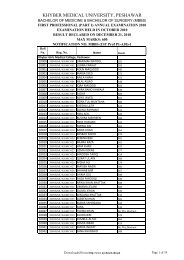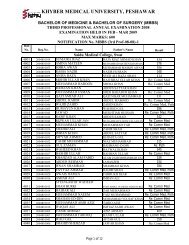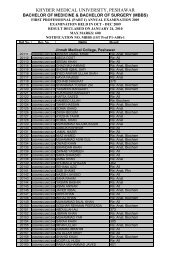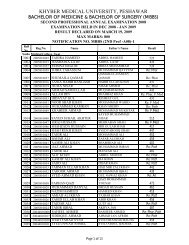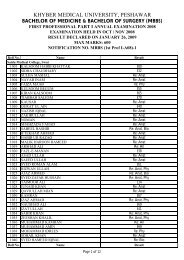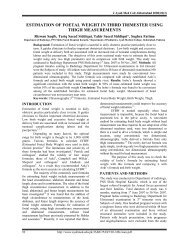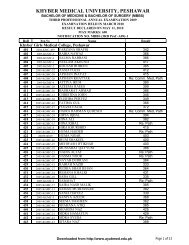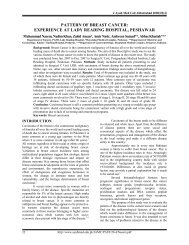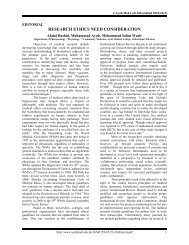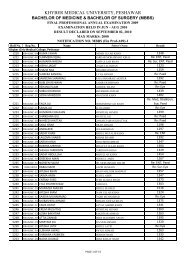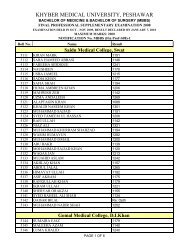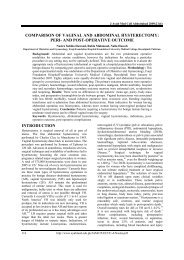diabetic foot infections and their management in a tertiary care hospital
diabetic foot infections and their management in a tertiary care hospital
diabetic foot infections and their management in a tertiary care hospital
You also want an ePaper? Increase the reach of your titles
YUMPU automatically turns print PDFs into web optimized ePapers that Google loves.
J Ayub Med Coll Abbottabad 2011;23(1)<br />
ORIGINAL ARTICLE<br />
DIABETIC FOOT INFECTIONS AND THEIR MANAGEMENT IN A<br />
TERTIARY CARE HOSPITAL<br />
Azizul Hasan Aamir, Ahmed Nasir, Mohammad Zahid Jadoon*, Khalid Mehmood**,<br />
Sobia Sabir Ali<br />
Department of Diabetes, Endocr<strong>in</strong>ology <strong>and</strong> Metabolic Diseases, Postgraduate Medical Institute, *Hayatabad Medical Complex,<br />
*Pakistan Institute of Community Ophthalmology, ** Postgraduate Medical Institute, Lady Read<strong>in</strong>g Hospital, Peshawar, Pakistan<br />
Background: Diabetic <strong>foot</strong> is a common complication of diabetes world over. We conducted this study<br />
to determ<strong>in</strong>e common microbiological pathogens <strong>in</strong> Diabetic Foot Infections (DFI) at a <strong>tertiary</strong> <strong>care</strong><br />
<strong>hospital</strong> <strong>and</strong> <strong>their</strong> <strong>management</strong>. Methods: In this observational study deep wound swabs of all admitted<br />
<strong>diabetic</strong> patients were taken, pathogens isolated, antibiotic used <strong>and</strong> its response depend<strong>in</strong>g on complete<br />
resolution of symptoms <strong>and</strong> biochemical markers were recorded. Data were analysed on SPSS-11.<br />
Results: A total of 114 cases were recorded. Sixty-eight (59%) cases had ulcers on fore<strong>foot</strong>, 28 (25%)<br />
mid-<strong>foot</strong> <strong>and</strong> 18 (16%) h<strong>in</strong>d-<strong>foot</strong>. One hundred <strong>and</strong> four pathogens were isolated from wound swabs<br />
after debridement. Commonest pathogen isolated was Staphylococcus aureus (52, 46%) followed by E.<br />
coli (11, 10%), MRSA was found <strong>in</strong> 10 (9%) cases, streptococcus <strong>in</strong> 6 (5%) <strong>and</strong> pseudomonas <strong>in</strong> 5 (4%)<br />
cases. Polymicrobial <strong>in</strong>fection was also seen <strong>in</strong> a few cases. Surgical <strong>in</strong>tervention <strong>in</strong>cluded superficial<br />
debridement <strong>in</strong> 88 (77%) cases, toe amputation/fore<strong>foot</strong> amputation <strong>in</strong> 19 (17%) cases, <strong>and</strong> below/above<br />
knee (major) amputation <strong>in</strong> 7 (6%) cases. Commonest antibiotic used was Cefoperazone/Sulbactam <strong>in</strong><br />
43 (38%) cases, alone or <strong>in</strong> comb<strong>in</strong>ation, followed by Ceftraixone 36 (33%) cases. L<strong>in</strong>ezolid was used<br />
for MRSA. N<strong>in</strong>ety-four (82%) patients responded to treatment <strong>and</strong> were recorded as ‘cured’.<br />
Conclusion: Diabetic Foot ulcers often present with serious <strong>foot</strong> <strong><strong>in</strong>fections</strong>. Commonest pathogens are<br />
Staph. aureus, E. coli, Pseudomonas spp. <strong>and</strong> MRSA. Treatment was effective with<br />
Cefoperazone/Sulbactam <strong>and</strong> Ceftraixone. MRSA was treated successfully with L<strong>in</strong>ezolid.<br />
Keywords: Diabetic <strong>foot</strong>, Diabetic <strong>foot</strong> <strong><strong>in</strong>fections</strong> (DFI), Staph. Aureus, E. coli, MRSA, antibiotics<br />
INTRODUCTION<br />
Foot ulcers rema<strong>in</strong> one of the most distress<strong>in</strong>g<br />
complications of a <strong>diabetic</strong> patient. 1,2 With high<br />
prevalence of diabetes <strong>in</strong> Pakistan 3 , chronic<br />
complications like <strong>foot</strong> ulcerations are high <strong>and</strong> also<br />
because of poor <strong>in</strong>frastructure at primary level <strong>and</strong> late<br />
referral of the leg ulcer cases to <strong>tertiary</strong> <strong>care</strong> <strong>hospital</strong>s<br />
contribute to higher numbers. Apart from common<br />
causes of <strong>foot</strong> ulcer 4 (neuropathy, deformity <strong>and</strong> <strong>in</strong>jury<br />
to the <strong>foot</strong>) <strong>in</strong>fection leads to devastat<strong>in</strong>g complications<br />
<strong>in</strong>clud<strong>in</strong>g sepsis, osteomyelitis, amputations <strong>and</strong> death<br />
<strong>in</strong> severe cases. It is estimated that approximately 85%<br />
of amputations precede a <strong>foot</strong> ulcer. 5–7 Thus outcomes<br />
of <strong>foot</strong> ulcers depend at what stage of the disease<br />
patients presents. In Pakistan amputation rate has been<br />
shown to be as high as 21–48%. 8–10 Most of the cases if<br />
identified early <strong>and</strong> treated appropriately <strong>in</strong>itially <strong>in</strong> the<br />
community can be treated effectively with antibiotics at<br />
an early stage <strong>and</strong> <strong>in</strong> an out patient sett<strong>in</strong>g. 11 But<br />
unfortunately because of the late referrals primarily <strong>and</strong><br />
also alternate medic<strong>in</strong>es, herbal medic<strong>in</strong>es, <strong>and</strong> poor<br />
medical facilities <strong>in</strong> the far flung <strong>and</strong> tribal areas, less<br />
knowledge regard<strong>in</strong>g diabetes <strong>in</strong> general <strong>and</strong> <strong>foot</strong> ulcers<br />
<strong>in</strong> particular leads to loss of limbs <strong>and</strong> loss of life <strong>in</strong><br />
some cases even when they reach a <strong>tertiary</strong> <strong>care</strong><br />
<strong>hospital</strong>.<br />
We aimed to conduct this observational study<br />
to obta<strong>in</strong> a real picture from large number of cases<br />
which were be<strong>in</strong>g seen at a <strong>tertiary</strong> <strong>care</strong> teach<strong>in</strong>g<br />
<strong>hospital</strong> one of the three largest <strong>hospital</strong>s <strong>in</strong> the<br />
prov<strong>in</strong>ce. Because of the close proximity to Afghanistan<br />
border which is only 50 kilometres from Peshawar city<br />
centre large number of referrals were from neighbour<strong>in</strong>g<br />
country Afghanistan. Because of recent unrest <strong>in</strong> tribal<br />
areas <strong>and</strong> neighbour<strong>in</strong>g Afghanistan medical facilities<br />
are either nonexistent or very primitive <strong>in</strong> these areas.<br />
We planned to study the type of<br />
microbiological <strong><strong>in</strong>fections</strong> commonly seen <strong>and</strong><br />
antibiotics used to treat them <strong>in</strong> a <strong>diabetic</strong> <strong>foot</strong> referred<br />
to <strong>foot</strong> cl<strong>in</strong>ic of Department of Diabetes, Endocr<strong>in</strong>e <strong>and</strong><br />
Metabolic Diseases at Postgraduate Medical Institute,<br />
Hayatabad Medical Complex, Peshawar, Pakistan.<br />
METHODS<br />
This observational study was carried out between<br />
September 2005 <strong>and</strong> December 2006. The study was<br />
approved by <strong>hospital</strong> ethical committee. All patients<br />
attend<strong>in</strong>g the outpatients department <strong>and</strong> later requir<strong>in</strong>g<br />
admission to the <strong>hospital</strong> with <strong>diabetic</strong> <strong>foot</strong> were<br />
<strong>in</strong>cluded <strong>in</strong> the study. Patients who were seen <strong>in</strong> the<br />
outpatients <strong>and</strong> were not admitted were excluded from<br />
the study. Data was collected on a performa <strong>and</strong><br />
transferred to computer.<br />
All patients with diabetes mellitus accord<strong>in</strong>g<br />
to WHO def<strong>in</strong>ition 1999 12 <strong>and</strong> <strong>foot</strong> ulcer were<br />
<strong>in</strong>cluded <strong>in</strong> the study. Diabetic <strong>foot</strong> <strong>in</strong>fection was<br />
58<br />
http://www.ayubmed.edu.pk/JAMC/23-1/Aziz.pdf
J Ayub Med Coll Abbottabad 2011;23(1)<br />
def<strong>in</strong>ed cl<strong>in</strong>ically <strong>and</strong> bio chemically on the basis of<br />
<strong>foot</strong> ulcer with purulent discharge <strong>and</strong> with three or<br />
more of the follow<strong>in</strong>g <strong>in</strong>clud<strong>in</strong>g fever(>38c) or whit<br />
cell count >10000mm 3 , localized oedema, signs of<br />
<strong>in</strong>flammation like erythema, tenderness, pa<strong>in</strong>, warmth<br />
or <strong>in</strong>duration. 13 Patients with suspected osteomyelitis<br />
were referred for radiological exam<strong>in</strong>ation <strong>in</strong>clud<strong>in</strong>g<br />
pla<strong>in</strong> X-ray <strong>and</strong> Magnetic Resonance Imag<strong>in</strong>g <strong>and</strong><br />
were also <strong>in</strong>cluded <strong>in</strong> this study.<br />
Deep tissue swabs were collected from the<br />
patient’s wounds <strong>and</strong> were tested <strong>in</strong> local <strong>hospital</strong><br />
microbiological laboratory. As patients were com<strong>in</strong>g<br />
from far flung tribal areas <strong>and</strong> also from Afghanistan<br />
<strong>and</strong> those who were even on antibiotics but cl<strong>in</strong>ically<br />
unwell as described above were swabbed after<br />
necessary debridement.<br />
All the demographic data was collected <strong>and</strong><br />
<strong>in</strong>cluded general <strong>in</strong>formation as well as duration of<br />
diabetes, <strong>diabetic</strong> control as assessed by HbA 1 c other<br />
<strong>diabetic</strong> complications specially neuropathy,<br />
deformity, peripheral vascular disease <strong>and</strong> other comorbid<br />
conditions. Ret<strong>in</strong>opathy was diagnosed after<br />
do<strong>in</strong>g fundoscopy. Peripheral neuropathy was assessed<br />
us<strong>in</strong>g the modified neuropathy disability score<br />
system. 14 A six-po<strong>in</strong>t <strong>foot</strong> deformity score assessed<br />
small muscle wast<strong>in</strong>g, hammer or claw toes, bony<br />
prom<strong>in</strong>ences, prom<strong>in</strong>ent metatarsal heads, charcot<br />
arthropathy, <strong>and</strong> limited jo<strong>in</strong>t mobility; an overall<br />
score of
J Ayub Med Coll Abbottabad 2011;23(1)<br />
5 ulcers <strong>and</strong> were statistically significant (Table-1). Also<br />
there were more amputations <strong>in</strong> patients with longer<br />
duration of diabetes (Table-2).<br />
Table-1: Surgical <strong>in</strong>terventions by grades of <strong>foot</strong><br />
ulcers<br />
Type of Surgical Wagners Grad<strong>in</strong>g, n (%) Total<br />
Interventions Grade 2 Grade 3 Grade 4 Grade 5 n (%)<br />
Superficial<br />
debridement 71 (93.4) 16 (84.2) 1 (6.3) 0 (0) 88 (77.2)<br />
Toe/fore <strong>foot</strong><br />
amputation 5 (6.6) 3 (15.8) 11 (68.8) 0 (0) 19 (16.7)<br />
Above/below knee<br />
Amputation 0 (0) 0 (0) 4 (24.)) 3 (100) 7 (6.1)<br />
Total 76 19 16 3 114<br />
Table-2: Surgical <strong>in</strong>terventions by duration of<br />
diabetes<br />
Type of Surgical Duration of diabetes, n (%) Total<br />
Interventions ≤5 yrs >5–10 yrs >10 yrs<br />
Superficial<br />
debridement<br />
16 (88.9) 37 (75.5) 35 (74.5) 88 (77.2)<br />
Toe amputation 1 (5.6) 11 (22.4) 7 (14.9) 19 (16.7)<br />
Major Amputations 1 (5.6) 1 (2.0) 5 (10.6) 7 (6.1)<br />
Total 18 49 47 114<br />
DISCUSSION<br />
This study shows a cl<strong>in</strong>ical <strong>and</strong> microbiological survey<br />
of <strong>in</strong>fected <strong>diabetic</strong> <strong>foot</strong> ulcers <strong>in</strong> <strong>hospital</strong>ized patients <strong>in</strong><br />
our part of the world. This is the first study from North-<br />
West Prov<strong>in</strong>ce of Pakistan look<strong>in</strong>g at common<br />
pathogens <strong>in</strong>volved <strong>and</strong> <strong>their</strong> response to treatment <strong>in</strong><br />
cl<strong>in</strong>ical sett<strong>in</strong>g. Previous data from Pakistan is mostly on<br />
the cl<strong>in</strong>ical outcome of <strong>diabetic</strong> <strong>foot</strong> ulcers 8–10,16,17 <strong>and</strong><br />
most of the microbiological data is from other countries.<br />
Duration of diabetes <strong>and</strong> poor control are<br />
known risk factors for <strong>diabetic</strong> <strong>foot</strong> ulcers 18 as shown by<br />
Lipsky <strong>and</strong> Sheehan 19 . In our study most of the patients<br />
were poorly controlled. Many other studies from<br />
develop<strong>in</strong>g countries have reported similarly. 8–10,17<br />
Only 28% of our patients had history of<br />
trauma prior to develop<strong>in</strong>g ulcer while the other<br />
majority of patients that is 72% didn’t remember any<br />
trauma which correlates with peripheral neuropathy<br />
present <strong>in</strong> 61% of our patients. As peripheral neuropathy<br />
is considered to be a major contributor for develop<strong>in</strong>g<br />
<strong>diabetic</strong> <strong>foot</strong> ulcer 21 , it need to be stressed to the treat<strong>in</strong>g<br />
physicians especially <strong>in</strong> primary <strong>care</strong> sett<strong>in</strong>gs to confirm<br />
the presence or absence of neuropathy <strong>in</strong> order to<br />
identify <strong>foot</strong> at risk.<br />
Our results confirmed that most of the ulcers<br />
were <strong>in</strong> the fore<strong>foot</strong>. Lipsky 21 showed that around 50%<br />
of <strong><strong>in</strong>fections</strong> <strong>in</strong>volved the toes, <strong>and</strong> similar results were<br />
seen by Kaufman. 22<br />
We used Wagner’s classification for ulcers<br />
because of its simplicity <strong>and</strong> <strong>in</strong> our report most of the<br />
cases were of grade 2–5. This signifies the fact that<br />
ulcers are not well managed <strong>in</strong> the community <strong>in</strong> our<br />
sett<strong>in</strong>g because of poor <strong>in</strong>frastructure <strong>and</strong> health system<br />
<strong>in</strong> develop<strong>in</strong>g world. 23<br />
In our survey microbiological studies were<br />
done <strong>in</strong> all patients <strong>in</strong>clud<strong>in</strong>g those who were on<br />
antibiotics prior to admission to the <strong>hospital</strong>. This<br />
yielded 104 pathogens. Many organisms may cause<br />
<strong><strong>in</strong>fections</strong> <strong>in</strong> <strong>diabetic</strong> <strong>foot</strong> ulcer patients, but grampositive<br />
cocci are the most frequent <strong>and</strong> virulent<br />
pathogens giv<strong>in</strong>g systemic symptoms. The commonest<br />
organism was Staph. aureus like other studies reported<br />
earliar. 24,25 This is also <strong>in</strong> l<strong>in</strong>e with some of the local<br />
studies from southern part of the country where aga<strong>in</strong><br />
Staph. aureus was the ma<strong>in</strong> isolated pathogen. 8,9<br />
Pseudomonas which is also considered to be a pathogen<br />
responsible for severe tissue damage <strong>in</strong> <strong>diabetic</strong> patients,<br />
should never be considered as <strong>in</strong>significant <strong>in</strong> <strong>foot</strong><br />
ulcers unless its role as a pathogen has been<br />
excluded. 26,27 Abdul Razak et al showed <strong>in</strong> 86<br />
consecutive <strong>diabetic</strong> patients that Staph. Aureus (38.4%)<br />
was the most common isolate be<strong>in</strong>g recovered from the<br />
cases. Other organisms were Pseudomonas aurigenosa<br />
(17.5%), P. mirabilis <strong>and</strong> anaerobic gram-negative<br />
organisms. This is <strong>in</strong> contrast to our study where<br />
although Staph. aureus was the ma<strong>in</strong> isolated organism<br />
(46%), followed by E. coli 10%, <strong>and</strong> Pseudomonas was<br />
isolated <strong>in</strong> only 4% of cases.<br />
As gram-positives are the most isolated<br />
organisms <strong>in</strong> most studies, we used <strong>in</strong>travenous<br />
Cefoperazone/Sulbactam <strong>and</strong>/or Ceftraixone empirically<br />
to treat <strong>in</strong>fection per policy of the unit. It yielded almost<br />
92% success depend<strong>in</strong>g on cure or improvement <strong>in</strong><br />
cl<strong>in</strong>ical condition as per protocol. But where other<br />
organisms or multiple organisms were isolated<br />
antibiotics were switched depend<strong>in</strong>g on the<br />
microbiological <strong>and</strong> sensitivity results. Other antibiotics<br />
used were Ciprofloxacill<strong>in</strong>, cl<strong>in</strong>damyc<strong>in</strong>, vancomyc<strong>in</strong><br />
<strong>and</strong> Piperacill<strong>in</strong>/Tazobactum. Their use <strong>in</strong> percentile is<br />
shown <strong>in</strong> graph below.<br />
There is <strong>in</strong>creas<strong>in</strong>g prevalence of MRSA<br />
species worldwide 28–30 which requires aggressive<br />
therapy as <strong>in</strong>fection with this organism may have a<br />
worse outcome <strong>and</strong> leaves treat<strong>in</strong>g physician with<br />
smaller choice <strong>in</strong> terms of use of antibiotics. We noticed<br />
higher number (9%) of MRSA <strong>in</strong>fection <strong>in</strong> our cases<br />
which is generally not recognised serious at primary<br />
<strong>care</strong> level <strong>in</strong> our setup. As we recruited all the patients<br />
<strong>in</strong>clud<strong>in</strong>g those who were receiv<strong>in</strong>g antibiotics <strong>in</strong> the<br />
community prior to admission to our <strong>tertiary</strong> <strong>care</strong> unit<br />
<strong>and</strong> may be one reason lead<strong>in</strong>g to selective survival<br />
advantage of pathogen. Recently two cases of even<br />
Vancomyc<strong>in</strong> resistant Staph. aureus have been<br />
reported. 31 Traditionally, <strong>diabetic</strong> <strong>foot</strong> <strong><strong>in</strong>fections</strong> have<br />
been treated by <strong>in</strong>travenous antibiotics to assure<br />
adequate antibiotic concentrations, especially <strong>in</strong> patients<br />
with severe <strong>in</strong>fection. Newer agents with therapeutically<br />
equivalent <strong>in</strong>travenous <strong>and</strong> oral formulations allow<br />
<strong>in</strong>itial treatment to be oral for persons who are cl<strong>in</strong>ically<br />
stable <strong>and</strong> allow an early switch from <strong>in</strong>travenous to<br />
60<br />
http://www.ayubmed.edu.pk/JAMC/23-1/Aziz.pdf
J Ayub Med Coll Abbottabad 2011;23(1)<br />
oral antibiotics for those who are respond<strong>in</strong>g to therapy.<br />
In our study we used L<strong>in</strong>ezolid orally, as this was the<br />
only formulation available <strong>and</strong> was used after the report<br />
of sensitivity was confirmed.<br />
L<strong>in</strong>ezolid is effective for treatment of<br />
<strong><strong>in</strong>fections</strong> due to gram-positive bacteria, <strong>in</strong>clud<strong>in</strong>g<br />
methicill<strong>in</strong>-, cephalospor<strong>in</strong>-, <strong>and</strong> vancomyc<strong>in</strong>-resistant<br />
stra<strong>in</strong>s 32,33 , but it has m<strong>in</strong>imal activity aga<strong>in</strong>st gramnegative<br />
bacteria. A highly bio-available oral<br />
formulation, is adm<strong>in</strong>istered twice per day, <strong>and</strong> achieves<br />
therapeutic concentrations <strong>in</strong> soft tissue <strong>and</strong> bone. 34,35<br />
However, as L<strong>in</strong>ezolid is expensive, we preferred to<br />
reserve it for treatment of documented antibioticresistant<br />
organisms. In our study 28% of patients used<br />
comb<strong>in</strong>ation therapy, which was utilised for more<br />
severe <strong>foot</strong> ulcers at presentation <strong>in</strong> comparison with<br />
moderate ones.<br />
For the empirical treatment of severe<br />
<strong><strong>in</strong>fections</strong>, Infectious Diseases Society of America<br />
(IDSA) suggests use of comb<strong>in</strong>ation antibiotic therapy<br />
or broad spectrum antibiotics. 13 IDSA also suggest use<br />
of oral antibiotics for most mild to moderate <strong><strong>in</strong>fections</strong>.<br />
In our study we only used mostly <strong>in</strong>travenous antibiotics<br />
because of moderate to severe <strong><strong>in</strong>fections</strong> <strong>and</strong> also as it<br />
was an <strong>in</strong>patient sett<strong>in</strong>g.<br />
F<strong>in</strong>ally, we observed that median duration of<br />
antibiotic therapy was 52 days (range 21–130) days.<br />
IDSA guidel<strong>in</strong>es suggest that the duration of antibiotic<br />
treatment should be 1–2 weeks for mild <strong><strong>in</strong>fections</strong>, 2–4<br />
weeks for moderate <strong><strong>in</strong>fections</strong> <strong>and</strong> ≥6 weeks for residual<br />
osteomyelitis <strong>and</strong> severe deep tissue <strong><strong>in</strong>fections</strong>. This<br />
was rather long duration of treatment but that aga<strong>in</strong> can<br />
be expected <strong>in</strong> our <strong>in</strong>patient sett<strong>in</strong>g where patients<br />
admitted were usually very ill <strong>and</strong> required long term<br />
antibiotic therapy particularly <strong><strong>in</strong>fections</strong> <strong>in</strong>volv<strong>in</strong>g deep<br />
tissues <strong>and</strong> bone.<br />
To our knowledge this is the first study from<br />
Northern Pakistan highlight<strong>in</strong>g the potential<br />
microbiological data <strong>and</strong> use of appropriate antibiotics.<br />
In some respects choice of antibiotics may have been<br />
different consider<strong>in</strong>g gram-negative load <strong>in</strong> chronic<br />
wounds but another study to compare different<br />
antibiotics may give an answer to this, though it is well<br />
established that while treat<strong>in</strong>g DFI gram positive should<br />
be first consideration pend<strong>in</strong>g the results of culture <strong>and</strong><br />
sensitivity.<br />
University of Texas grad<strong>in</strong>g may have been<br />
appropriate to highlight the grad<strong>in</strong>g <strong>in</strong> more detail. This<br />
system, which comb<strong>in</strong>es grade <strong>and</strong> stage, is more<br />
descriptive <strong>and</strong> shows a greater association with<br />
<strong>in</strong>creased risk of amputation <strong>and</strong> prediction of ulcer<br />
heal<strong>in</strong>g when compared with the Wagner system. 36 In<br />
our study we didn’t <strong>in</strong>clude heal<strong>in</strong>g time as the outcome<br />
predictor <strong>in</strong> which case University of Texas<br />
classification may have been a better way to determ<strong>in</strong>e<br />
the outcome.<br />
CONCLUSION<br />
DFIs are common <strong>in</strong> <strong>diabetic</strong>s <strong>and</strong> pose serious health<br />
problems for develop<strong>in</strong>g countries. Common aetiology is<br />
Staph. aureus, E. coli, <strong>and</strong> Pseudomonas which can be<br />
treated effectively with cephaperazone/β-lactamase<br />
<strong>in</strong>hibitors, ceftraixone <strong>and</strong> flouroqu<strong>in</strong>olones. MRSA is<br />
also seen <strong>in</strong> <strong>diabetic</strong> <strong>foot</strong> ulcers <strong>and</strong> can be effectively<br />
treated with L<strong>in</strong>ezolid orally.<br />
REFERENCES<br />
1. Abbott CA, Carr<strong>in</strong>gton AL, Ashe H, Bath S, Every LC, Griffiths<br />
J, et al. The north-west diabetes <strong>foot</strong> <strong>care</strong> study: <strong>in</strong>cidence of, <strong>and</strong><br />
risk factor for, new <strong>diabetic</strong> <strong>foot</strong> ulceration <strong>in</strong> community-based<br />
patient cohort. Diabet Med 2002;19:377–84.<br />
2. Katsilambros N, Dounis E, Nicholas Tentolouris, Tsapogas P.<br />
Atlas of the <strong>diabetic</strong> <strong>foot</strong>. Hoboken NJ: Jon Wiley & Sons Ltd;<br />
2003.<br />
3. International Diabetes Federation. Diabetes atlas. Executive<br />
summary. 2 nd ed. Belgium IDF; 2003.<br />
4. Boulton AJ, Kirsner RS, Vileikyte L. Cl<strong>in</strong>ical practice:<br />
neuropathic <strong>diabetic</strong> <strong>foot</strong> ulcers. N Engl J Med 2004;351:48–55.<br />
5. S<strong>in</strong>gh N, Armstrong DG, Lipsky BA. Prevent<strong>in</strong>g <strong>foot</strong> ulcers <strong>in</strong><br />
patients with diabetes. JAMA 2005;293:217–28.<br />
6. Lev<strong>in</strong> ME. Classification of <strong>diabetic</strong> <strong>foot</strong> wounds. Diabetes Care<br />
1998;21:855–9.<br />
7. Reiber GE, Boyko EJ, Smith DG. Lower extremity <strong>foot</strong> ulcers <strong>and</strong><br />
amputations <strong>in</strong> diabetes. In: Diabetes <strong>in</strong> America, Vol 2.<br />
Bethesda, MD: National Institutes of Health 1995.p. 409–27.<br />
8. Ali SM, Basit A, Sheikh T, Mumtaz S, Hydrie MZ. Diabetic <strong>foot</strong><br />
ulcer-A prospective study. J Pak Med Assoc 2001;51:78–81.<br />
9. Rooh UM, Ahmed M, Griff<strong>in</strong> S. Evaluation <strong>and</strong> <strong>management</strong> of<br />
<strong>diabetic</strong> <strong>foot</strong> accord<strong>in</strong>g to Wagner’s classification. A study of 100<br />
cases. J Ayub Med Coll Abbottabad 2003;15(3):39–42.<br />
10. Faizur Rehman, Nadir S. Diabetic Foot. J Postgrad Med Inst<br />
2004;18:463–9.<br />
11. Esposito S, Leone S, Noviello S, Foire M, Ianniello F, Felaco<br />
FM, et al. Foot <strong><strong>in</strong>fections</strong> <strong>in</strong> diabetes (DFI) <strong>in</strong> the out-patient<br />
sett<strong>in</strong>g: an italian multicentre observational survey. Diabet Med<br />
2008;25:979–84.<br />
12. World Health Organization Expert Committee. Def<strong>in</strong>ition,<br />
diagnosis <strong>and</strong> classification of diabetes mellitus <strong>and</strong> its<br />
complications. Report of a WHO consultation, part 1: Diagnosis<br />
<strong>and</strong> Classification of Diabetes Mellitus. Geneva: World Health<br />
Organization 1999.<br />
13. Lipsky BA, Berendt AR, Deery HG, Embil JM, Joseph WS,<br />
Karchmer AW. Diagnosis <strong>and</strong> treatment of <strong>diabetic</strong> <strong>foot</strong><br />
<strong><strong>in</strong>fections</strong>. Cl<strong>in</strong> Infect Dis 2004;39:885–910.<br />
14. Young MJ, Boulton AJ, Mac Leod AF, Williams DR, Sonksen<br />
PH. A multicentre study of the prevalence of <strong>diabetic</strong> peripheral<br />
neuropathy <strong>in</strong> the United K<strong>in</strong>gdom <strong>hospital</strong> cl<strong>in</strong>ic population.<br />
Diabetologia 1993;36:150–4.<br />
15. Wagner FW Jr. The dysvascular <strong>foot</strong>: a system for diagnosis <strong>and</strong><br />
treatment. Foot Ankle 1981;2:64–122.<br />
16. Zafar A. Management of <strong>diabetic</strong> <strong>foot</strong>: two years experience. J<br />
Ayub Med Coll Abbottabad 2001;13(1):14–6.<br />
17. Ali SM, Basit A, Fawwad A, Ahmedani MY, Miyan Z, Malik<br />
RA. Presentation <strong>and</strong> outcome of <strong>diabetic</strong> <strong>foot</strong> at a <strong>tertiary</strong> <strong>care</strong><br />
unit. Pak J Med Sci 2008;24:651–6.<br />
18. Lev<strong>in</strong> ME. Classification of <strong>diabetic</strong> <strong>foot</strong> wounds. Diabetes Care<br />
1998;21:681.<br />
19. Lipsky BA, Sheehan P, Armstrong DG, Tice AD, Polis AB,<br />
Abramson MA. Cl<strong>in</strong>ical predictors of treatment failure for<br />
<strong>diabetic</strong> <strong>foot</strong> <strong><strong>in</strong>fections</strong>: data from a perspective trial. Int Wound J<br />
2007;4:30–8.<br />
20. Boulton A. Lawrence lecture. The <strong>diabetic</strong> <strong>foot</strong>: neuropathic <strong>in</strong><br />
aetiology? Diabet Med 1990;7:852–8.<br />
http://www.ayubmed.edu.pk/JAMC/23-1/Aziz.pdf 61
J Ayub Med Coll Abbottabad 2011;23(1)<br />
21. Lipsky BA, Armstrong DG, Citron DM, Tice AD, Morgenstern<br />
DE, Abramson MA. Ertapenem versus piperacill<strong>in</strong>/ tazobactam<br />
for <strong>diabetic</strong> <strong>foot</strong> <strong><strong>in</strong>fections</strong> (SIDESTEP): prospective,<br />
r<strong>and</strong>omised, controlled, double- bl<strong>in</strong>ded, multicentre trial, Lancet<br />
2005;366:1695–703.<br />
22. Kaufman J, Breed<strong>in</strong>g L, Rosenberg N. Anatomic location of<br />
acute <strong>diabetic</strong> <strong>in</strong>fection. Its <strong>in</strong>fluence on the outcome of<br />
treatment. Am Surg 1987;53:109–112.<br />
23. Vijay V, Snehalatha C, Ramach<strong>and</strong>ran A. Sociocultural practice<br />
that may affect the development of the <strong>diabetic</strong> <strong>foot</strong>. IDF Bull<br />
1997;42:10-2.<br />
24. Sapico FL, Witte JL, Canawati HN, Montgomerie JZ, Bessman<br />
AN. The <strong>in</strong>fected <strong>foot</strong> of the <strong>diabetic</strong> patient: quantitative<br />
microbiology <strong>and</strong> analysis of cl<strong>in</strong>ical features. Rev Infec Dis<br />
1984;6(Suppl 1):171–6.<br />
25. Ge Y, MacDonald D, Hait H, Lipsky BA, Zasloff M, Holroyd K,<br />
Microbiological profile of <strong>in</strong>fected <strong>diabetic</strong> <strong>foot</strong> ulcers. Diabet<br />
Med 2002;19:1032–5.<br />
26. Wheat LJ, Allen SD, Henry M, Kernek CB, Siders JA, Kuebler<br />
T. Diabetic <strong>foot</strong> <strong><strong>in</strong>fections</strong>. Arch Intern Med 1986;146:1935–40.<br />
27. Abdulrazak A, Bitar ZI, Al-Shamali AA, Mobasher LA.<br />
Bacteriological study of <strong>diabetic</strong> <strong>foot</strong> <strong><strong>in</strong>fections</strong>. J Diabetes<br />
Complications 2005;19:138–41.<br />
28. Mantey I, Hill RL, Foster AV, Wilson S, Wade JJ, Edmonds ME.<br />
Infection of <strong>foot</strong> ulcers with Staphylococcus aureus associated<br />
with <strong>in</strong>crease mortality <strong>in</strong> <strong>diabetic</strong> patients. Commun Dis Public<br />
Health 2000;3:288–90.<br />
29. Dang CN, Prasad YD, Boulton AW, Jude EB. Methicill<strong>in</strong>resistant<br />
Staphylococcus aureus <strong>in</strong> the <strong>diabetic</strong> <strong>foot</strong> cl<strong>in</strong>ic: a<br />
worsen<strong>in</strong>g problem. Diabet Med 2003;20:159–61.<br />
30. Fluckiger U, Widmer AF. Epidemiology of methicill<strong>in</strong>-resistant<br />
Staphylococcus aureus. Chemotherapy 1999;45:121–34.<br />
31. Centers for Disease Control <strong>and</strong> Prevention. Vancomyc<strong>in</strong>resistant<br />
Staphylococcus aureus-Pennsylvania, 2002. MMWR<br />
Morb Mortal Wkly Rep 2002;51:902.<br />
32. Rub<strong>in</strong>ste<strong>in</strong> E, Cammarata SK, Oliphant TH, Wunder<strong>in</strong>k RG.<br />
L<strong>in</strong>ezolid (PNU-100766) versus vancomyc<strong>in</strong> <strong>in</strong> the treatment of<br />
<strong>hospital</strong>ized patients with nosocomial pneumonia: a r<strong>and</strong>omized,<br />
double-bl<strong>in</strong>d, multicenter study. L<strong>in</strong>ezolid Nosocomial<br />
Pneumonia Study Group. Cl<strong>in</strong> Infect Dis 2001;32:402–12.<br />
33. Stevens DL, Herr D, Lampiris H, Hunt JL, Batts DH, Hafk<strong>in</strong> B.<br />
L<strong>in</strong>ezolid versus vancomyc<strong>in</strong> for the treatment of methicill<strong>in</strong>resistant<br />
Staphylococcus aureus <strong><strong>in</strong>fections</strong>. L<strong>in</strong>ezolid MRSA<br />
Study Group. Cl<strong>in</strong> Infect Dis 2002;34:1481–90.<br />
34. Lover<strong>in</strong>g AM, Zhang J, Bannister GC, Lankester BJ, Brown JH,<br />
Narendra G, et al. Penetration of l<strong>in</strong>ezolid <strong>in</strong>to bone, fat, muscle<br />
<strong>and</strong> haematoma of patients undergo<strong>in</strong>g rout<strong>in</strong>e hip replacement. J<br />
Antimicrob Chemother 2002;50:73–7.<br />
35. Rana B, Butcher I, Grigoris P, Murnaghan C, Seaton RA, Tob<strong>in</strong><br />
CM. L<strong>in</strong>ezolid penetration <strong>in</strong>to osteo-articular tissues. J<br />
Antimicrob Chemother 2002;50:747–50.<br />
36. Oyibo SO, Jude EB, Tarawneh I, Nguyen HC, Harkless LB,<br />
Boulton AJ. A Comparison of Two Diabetic Foot Ulcer<br />
Classification Systems. Diabetes Care 2001;24:84–8.<br />
Address for Correspondence:<br />
Dr. A. H. Aamir, Associate Professor, Department of Diabetes, Endocr<strong>in</strong>ology <strong>and</strong> Metabolic Diseases, Postgraduate<br />
Medical Institute, Hayatabad Medical Complex, Peshawar, Pakistan. Cell: + 92-91-9217794<br />
Email: drahaamir@gmail.com<br />
62<br />
http://www.ayubmed.edu.pk/JAMC/23-1/Aziz.pdf



